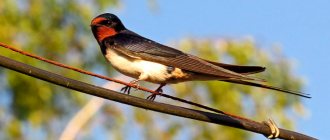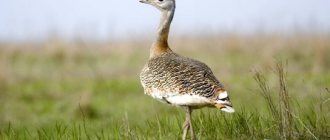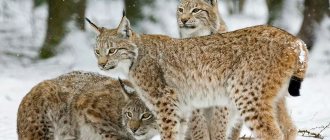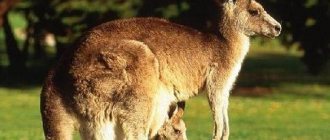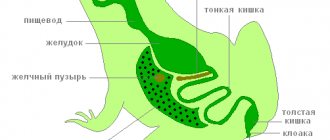- Reports
- Birds
- Tit
The tit is a small, lively bird belonging to the passerine order. Friendly, trusting, loves to twitter. Experts say that it is capable of producing over 40 different sound combinations.
The tit weighs 14-20 grams, and its body length does not exceed 15-20 centimeters. It has tenacious claws and a neat short beak, which is slightly flattened on the sides. It flies quite quickly, but rarely flaps its wings, saving vital energy.
A distinctive feature of most species of tits is a dark “cap” on the head and a beautiful bright yellow or lemon color of the abdomen, as well as a longitudinal black stripe on it. The stripe-tie in males widens slightly towards the tummy. In females, on the contrary, it narrows. In addition, their plumage color is a little lighter than that of males.
The tit lays eggs 2 times a year. Their number in a clutch can reach up to 15 pieces. The surface of the eggs is covered with reddish-brown spots.
The parents surround the hatched chicks with care. They especially diligently ensure that the offspring are not hungry, and almost every minute they put something tasty into their voracious beaks.
The habitat of tits is quite wide: Eurasia, some Asian countries, northwestern Africa. Gardens, parks, and the edges of deciduous forests are their favorite places to live. These birds prefer to settle in nests and hollows abandoned by other birds.
They are not picky about food. True, their diet changes depending on the season. In winter, they eat seeds of spruce, pine, birch, and linden. In the warm season, they feed on small beetles, midges, mosquitoes, spiders, etc., and feed their chicks with caterpillars. Interestingly, the mass of food that a tit eats during the day is almost the same as its own weight.
Tits are real healers of forests, gardens and parks. They save trees from harmful insects, which they skillfully remove from under the bark. It’s hard to believe, but one tit can “heal” more than 20 trees. Therefore, it is not surprising that even in the legislative act of Louis of Bavaria, dated 1328, a large fine was provided for any person who dared to kill this useful bird.
Tits: description
The word "tit" is directly related to the "blue color", as it represents the color of the blue tit bird, which was previously mistakenly classified as a tit. It is characteristic that previously many species of birds were classified as representatives of the “tit” family, but in our time they have been classified as other species.
Appearance
Subspecies of tits such as long-tailed and thick-billed tits should also be classified in this family. Scientists know that in nature there are more than a hundred species of birds that are classified as tits. At the same time, it is customary to consider those birds that are actually included in the list of this family to be true tits. The gray tit differs from other representatives of this genus in that it has a black stripe along its abdomen and lacks a crest. At the same time, her back is gray, she has a black “cap,” there are white spots on her cheeks, and her chest is light. The abdomen is also white, and there is a black stripe down the center.
Interesting to know! The tail feathers are slightly blackish and the rump has an ashen tint.
The undertail is characterized as black in the center and white on the sides. The great tit is considered a fairly active and energetic bird. Its body length is on average about 15 cm, and its average weight is 20 grams. The wingspan of a tit reaches an average value of about 25 cm. This bird has a black head and neck, the upper part is characterized by an olive tint, and the lower part is yellow. The tit's cheeks are pure white, which clearly catches the eye. The color of the plumage can vary significantly, depending on the subspecies of this genus.
Behavior and lifestyle
The tit is a rather lively and curious creature that cannot sit in one place for even a second. It is in constant motion, although it is considered a very unpretentious bird in relation to its habitat. The tit has virtually no rivals who could demonstrate the same dexterity and curiosity. The tit has strong and quite tenacious legs, so it demonstrates miracles of mobility, so it is quite interesting to watch it.
This bird also demonstrates unique abilities in terms of survival, especially in extreme conditions, even if it is far from its nest. She clings to a branch with her claws and instantly falls asleep, turning into a fluffy ball. This feature of its behavior helps the titmouse survive in even the most severe winter cold.
Almost all species of titmouse lead a mostly sedentary lifestyle, although some species are prone to periodic migrations.
And yet, regardless of the type of tit, they are united only by their unique characteristics associated with the beautiful, memorable color of their plumage, incredibly lively behavior, as well as their athletic form and unique singing, by which it is easy to distinguish a tit from any other bird.
The tit molts no more than once a year.
Interesting fact! As a rule, gray tits can be seen in pairs, but sometimes they gather in small flocks, if we consider each species group separately. This is due to the fact that there is a lack of food supply, so the process of searching for food is more productive if the birds search for food together.
By nature, all types of tits are considered the category of birds that can safely be called green space orderlies. Tits destroy a huge number of harmful insects, saving green spaces from death. One family of tits clears up to 40 trees of pests to feed their offspring. Tits communicate with each other using sounds that are easy to distinguish from the sounds of other species of birds.
Interesting facts about tits
How long do tits live?
In the natural environment, tits do not live long, only about 3 years, but when kept in artificial conditions they live up to 15 years. But this is only if all the details of their maintenance are observed, along with proper nutrition.
Sexual dimorphism
If a person is not an expert, then he is unlikely to be able to distinguish a female tit from a male, since they are almost identical in appearance. But if you place them side by side and look closely, you will notice that the females have a narrower and duller stripe located along the abdomen. The same can be said about the rest of the body, so the black head and black neck of the male differ in that in the female these colors are more in the area of black-gray shades. In this case, the color of the neck may not be solid, just like the color of the stripe.
Description[edit | edit code]
Appearance[edit | edit code]
An agile, fidgety bird. In Europe, the largest tit is about the size of a sparrow and has a fairly long tail. Length 13-17 cm, weight 14-21 g, wingspan 22-26 cm[2]. It has quite bright plumage, standing out among other birds primarily by its bright yellow belly with a “tie” - a wide black stripe from the chest to the tail. The top of the head, or cap, is black with a blue metallic sheen. Cheeks are white. There is a yellowish-white spot on the back of the head. There is a black collar stripe around the neck, the throat and chest are black with a slight bluish tint. The back is yellow-green or bluish-gray with a slight olive tint on the shoulders, the wings and tail are bluish. The three outer tails have white peaks, together forming a transverse light stripe. A thin white transverse stripe is also visible on the wing.
Females are similar to males, but are generally a little duller - the black tones on the head and chest have a grayer tint, the collar and black stripe on the belly are thinner and can sometimes be interrupted. The edge on the upper and middle coverts is greenish-gray rather than greenish-blue in males. The undertail is whiter. Young birds are similar to females, but their cap is rather brownish or brownish-olive, and the spot on the back of the head is small and vague. The species has a well-defined geographical variability - more than 30 subspecies are distinguished, differing in shades of color on the back, rump, chest, sides, and the intensity of white on the tail. In addition, a number of subspecies show slight ecological differences[2][3][4].
Singing[edit | edit code]
The great tit has a rich vocal repertoire - experts identify up to 40 variations of the sounds it makes. In this case, the same individual is simultaneously capable of alternating three to five options, different in rhythm, timbre, relative pitch of sounds and number of syllables. The male is especially active, singing throughout almost the entire year, with the exception of late autumn and early winter.
The song is a loud chime of “qi-qi-qi-pi”, “in-chi-in-chi”, the cry is a ringing “pin-pin-chrrrrzh”. In the spring, the monotonous song “zin-zi-ver”, “zin-zin”. She either whistles gently and quietly, then starts a loud roll call: “pin-pin-ping,” like a finch, then she cracks in fear: “pin-tarara,” or repeats her two-syllable whistle with endless intonations: “fi-fi.” At the end of winter, around February, great tits become more active. During the thaw, one can already hear their two- or three-syllable melody - a rhythmic repetition of ringing or sometimes “tinkling” sounds (“tsi-tsi-fi-tsi-tsi-fi” or “tsu-vi-tsu-vi-tsu-vi” ). Each singer has a unique intonation. Day after day, these chants become louder and longer, involuntarily attracting attention with their originality. The chaffinch has a similar chirping sound, but the tit has a more sonorous timbre. The song is often heard during communication between members of a pair, or when the bird is excited. In addition to the actual singing, there is also a so-called sub-song - a melodic quiet chirping, “purring”, most often performed in February or March [2] [4] [5].
Types of tits
In the database of the International Union of Ornithologists, 4 species of great gray tit are noted. These include:
- The gray tit belongs to a species that consists of several subspecies, which until recently represented the species of great tit.
- The great tit (Bolshak) is the largest and most common species.
- The Japanese tit (Eastern) also includes several subspecies, which differ in that they do not have frequent mixing of subspecies.
- Green-backed tit.
Until recently, the Eastern (Japanese) tit was considered one of the subspecies of the great tit, but through the efforts of some scientists it was possible to prove that these are two separate independent species.
TITMS, SIX SPECIES.
Where do tits spend the night in the city in winter, and where do they fly in summer?
You have probably noticed that most often titmouses can be seen in winter and late autumn, when the first snow and frosts appear outside. However, where do these little birds live in the summer?
- Tits are inhabitants of forests and various forest belts. At favorable times, that is, in summer and spring, they are there because they simply do not need to fly closer to people. In the forest they feel very protected, and they have much more food there than in other places.
- With the onset of winter and cold weather, the picture completely changes. There are fewer insects in the forests, and over time they disappear altogether. This is where titmice wander closer to people and their homes, because they know that here they have a better chance of finding food and overwintering.
Wintering of tits
- Tits spend the night in winter in places where they will be warm and least windy. Various hollows, cracks in buildings, and birdhouses are good places for these birds to spend the night; you can also see tits under the roofs of houses. Most often, birds spend the night in flocks, huddled closely together, because this way they are much warmer.
Natural habitats
It is known that the gray tit is represented by 13 subspecies, such as:
- Pc ambiguus, a subspecies found on the Malacca Peninsula and the island of Sumatra.
- Pc caschmirensis, distinguished by the presence of a gray spot on the back of the head. The habitat of this subspecies is represented by the northeast of Afghanistan, the north of Pakistan and the northwest of India.
- Pc cinereus Vieillot is a subspecies common on the island of Java, as well as on the Lesser Sunda Islands.
- Pc decolorans Koelz is found in the northwestern part of Afghanistan, as well as the northwestern part of Pakistan.
- Pc hainanus EJO Hartert is a subspecies native to Hainan Island.
- Pc intermedius Zarudny is a subspecies representing the territories of northeastern Iran and northwestern Turkmenistan.
- Pc mahrattarum EJO Hartert is a subspecies common in the northwestern part of India, as well as the island of Sri Lanka.
- Pc planorum EJO Hartert is distributed in northern India, Nepal, Bhutan, Bangladesh, central and western Myanmar.
- Pc sarawacensis Slater is a subspecies found on the island of Kalimantan.
- Pc stupae Koelz is found in western, central as well as northeastern parts of India.
- c. templorum Meyer de Schauensee. The central and western parts of Thailand, as well as southern Indochina, are represented by this subspecies.
- Pc vauriei Ripley is a subspecies whose habitat is represented by northeast India.
- Pc ziaratensis Whistler - this subspecies can be found in the south and center of Afghanistan, as well as in the west of Pakistan.
The great tit is distributed throughout almost the entire Middle East, as well as in Europe, North and Central Asia, including some areas of North Africa.
The great tit is represented by 15 subspecies, which are distinguished by a wider habitat. For example:
- Pm raphrodite is a subspecies found in southern Italy, southern Greece, islands located in the Aegean Sea and Cyprus.
- Pm blanfordi is found in the northern territories of Iraq, northern Afghanistan, and the southern central regions of Kazakhstan and Uzbekistan.
- Pm bokharensis - this subspecies is found in the territory of Turkmenistan, in the north of Afghanistan, as well as in the north of the central territories of Iran.
- PM corsus. A subspecies that inhabits the territory of Portugal, southern Spain and Corsica.
- PM ecki. Found in Sardinia.
- Pm excesus - lives in northwestern Africa, western Morocco and northwestern Tunisia.
- Pm ferghanensis is found in Tajikistan, Kyrgyzstan and western China.
- Pm kapustini is distributed in the southeast of Kazakhstan (Dzhungar Alatau), in the northwest of China and Mongolia, in Transbaikalia, in Primorye, including the north, up to the shores of the Sea of Okhotsk.
- Pm karelini is a subspecies distributed in southeastern Azerbaijan and northwestern Iran.
- Pm major is a typical representative of the European continent, Spain, the Balkans, northern Italy, Siberia, Asia Minor, the Caucasus, and Azerbaijan.
- Pm mallorcae is widespread in the Bamar Islands.
- Pm newtoni is a subspecies whose habitat is confined to the British Isles, the Netherlands, Belgium, as well as the northwestern regions of France.
- Pm niethammeri is found in the wild on the island of Crete.
- Pm terraesanctae, a species that lives in the territories of Lebanon, Syria, Israel, Jordan, as well as the northeastern territories of Egypt.
- Pm turkestanicus is a subspecies found in the southeastern part of Kazakhstan, as well as in the southwestern part of Mongolia.
Representatives of various species and subspecies choose areas in nature for their life activities, located within forests, in open areas and on the edges, as well as near natural reservoirs.
There are 9 subspecies of the Eastern (Japanese) tit. For example:
- Pm amamiensis is a subspecies found in the northern Ryukyu Islands.
- PM commixtus. The habitat of this subspecies is southern China and northern Vietnam.
- Pm dageletensis. A subspecies that is found on the Ulleungdo Islands, close to Korea.
- PM kagoshimae. A subspecies inhabiting the southern part of Kyushu and the Goto Islands.
- PM minor. It is found in eastern Siberia, southern Sakhalin, as well as northeastern China, Korea and Japan.
- Pm nigriloris. The subspecies lives in the south of the Ryukyu Islands.
- m. nubiсolus - subspecies lives in eastern Myanmar, northern Thailand and northwestern Indochina.
- m. okinawae - found in the center of the Ryukyu Islands.
- PM tibetanus. The subspecies is found in southern Tibet, southwestern China and northern Myanmar.
The habitat of the green-backed tit includes the territory of Bangladesh and Bhutan, the territory of China and India, Nepal, Pakistan, Thailand and Vietnam. This species of tit lives in boreal forests and woodlands of temperate latitudes, subtropics and tropical rainforests.
which of these birds is not migratory: nightingale, stork, tit, heron
It is only known that during flight, birds find many landmarks with the help of highly developed organs of hearing and vision, which are several times superior to human senses. Scientists do not even rule out that migrating birds are able to navigate by the location of the Sun, Moon and stars.
• Sandpiper - Tahitian curlew, nesting in Alaska, travels 9,000 km for the winter to small islands located in the central part of the Pacific Ocean. Neither winds, nor storms, nor the huge distance of flying over water, where there is not a single landmark, hinder him. During the Second World War, many pilots serving at airfields located on these islands could not even find their way back with the help of navigation instruments, and their planes, having used up their fuel supply, fell into the ocean. And waders have been coping with this task for tens of thousands of years.
Bird ringing method. Migration routes and wintering places of birds are studied in particular using the ringing method. For birds that are nesting or preparing to fly, a light metal ring is attached to their leg, on which the number of the ring and the name of the country where the bird is ringed are indicated. If a bird with a ring gets to a person, from this data you can find out about the place and time of ringing. And after re-catch, find out where and in what ways the bird is moving, the migration period and the wintering place. Using the ringing method, it was proven that birds always return to the places where they were born.
Each country has its own Bird Ringing Center, where information about birds ringed on the territory of that country that fall into human hands is transmitted. Thanks to flight, birds can move in search of favorable habitats over such vast distances that no other living creature is capable of moving. Every year, birds of many species make seasonal migrations over thousands of kilometers, accurately find their wintering places and always return to where they were born.
Small flocks of these bright birds can be seen in almost every Russian city, especially in winter. In the cold season tits , which usually live in the forest, move closer to human habitation, where it is easier for them to escape hunger. If you take a close look at these little birds, you may notice a difference in their plumage. The fact is that in fact the tit family unites more than six dozen species. Several species live in Russia, and they differ not only in their appearance, but also in their way of life.
Basically, these birds are sedentary, and only partially migrate from place to place over relatively short distances. But those individuals that live in the northern regions, for example, in the taiga, fly south in the fall. “Southern” tits , in turn, also move to areas that are warmer than their usual habitats. So it seems that these birds are going nowhere at all
do not fly away. The largest number of birds in the world are wood tits - about 40 species. They live in temperate and northern latitudes of Europe, North America and Asia, although they are also found here and there in India and Africa. Those that live in the European part of Russia fly away in large flocks in a southwestern direction in October.
This is interesting: The poorest countries in Europe 2019
Diet
When these birds actively breed, they eat small invertebrates, including their larvae. These birds, which are considered real forest orderlies, eat a lot of harmful insects. Despite this, the basis of the tit’s diet includes:
- Butterfly caterpillars.
- Spiders.
- Centipedes and other beetles.
- Diptera insects, including flies, mosquitoes and midges.
- Hemipteran living creatures, including bedbugs.
In addition, their diet includes cockroaches, grasshoppers and crickets, as well as small dragonflies, lacewings, earwigs, ants, ticks, millipedes, etc. A tit can also eat a bee after the sting is removed. After wintering, tits hunt bats - dwarfs, which with the arrival of spring are not particularly mobile and become accessible to these orderlies of nature. Tits feed their chicks mainly with butterfly caterpillars, the size of which does not exceed 1 cm.
With the arrival of autumn and then winter, the basis of the tit's diet consists of plant foods, in the form of hazel and Jewish beech seeds. Tits often migrate in search of food, visiting fields where grains of various crops such as corn, rye, oats, wheat and others remain.
In addition to the above food items of plant origin, depending on living conditions, tits feed on the fruits and seeds of the following plants:
- Spruce and pine trees.
- Maple and linden.
- Lilacs.
- Birches.
- Horse sorrel.
- Pikulnikov.
- Lopukhov.
- Red elderberry.
- Irgi.
- Rowan trees.
- Blueberries.
- Hemp and sunflower.
The great tit, unlike some other representatives of this genus, such as the blue tit and the tit, does not store reserves for the winter. The tit is such an agile bird that it easily finds food reserves collected by other birds. Some experts claim that the great tit is capable of eating all kinds of carrion.
Tits often fly into urban areas and visit parks and other places where bird feeders are installed. Here they find seeds, bread crumbs and other food scraps, butter and unsalted pieces of lard. They obtain food for themselves wherever possible, including in the crowns of trees, as well as in the fallen leaves of trees and shrubs.
Interesting information! The great tit is distinguished by the fact that it has a fairly extensive list of food items. She is capable of killing other smaller birds, after which she pecks out their brains.
The great tit has a fairly strong and powerful beak, which the bird uses to break nuts and other fruits with a hard surface before eating the tasty insides. Great tits are also characterized as carnivores, as they are known to feed on the remains of a variety of mammals.
Culinary preferences
Wild tits prefer small invertebrates and insects:
They deposit them in the bark of trees, and do not remember exactly the location of the food. This diet is typical for birds, preferably in the spring and summer months. The beginning of autumn is the time when birds look for berries, sunflower seeds, and pine cones.
In winter, tits empty their pantries and other various sources of food: they painstakingly examine all the branches of trees and chisel the bark.
When kept at home, tits are unpretentious in their diet. Suitable food consists of carrots, crackers from white (and only white) bread and a chicken egg. Mealworm larvae can be added to the main food.
You can throw crumbs of white bread, frozen blueberries, blueberries, rowan berries, viburnum, nuts, and seeds into the feeder. Tits do not eat raw cereals. It must be boiled, but not salted. In addition to salty food, birds should not be given smoked or fried food.
This is interesting: The smallest clothing size
Reproduction and offspring
Great tits (Bolshaki) in our country have quite large populations. These are monogamous birds that form pairs, after which they begin to form a nest. The female and male raise their offspring together. To build their nests, they choose light forests, where deciduous trees predominate, growing in the coastal zone, in gardens and parks. Coniferous areas are not suitable for nesting of these birds. A tit's nest can be located anywhere, including in niches of old buildings or in the hollows of old trees. Often tits occupy old nests abandoned by other birds at heights from 2 to 6 meters. Tits can easily settle in man-made buildings equipped for nesting.
To build a nest for themselves, birds collect and bring small blades of grass or twigs, roots of various plants, including moss. The inside of the nest is made softer and warmer, so the birds cover it with wool, cobwebs, cotton wool, down and feathers, and a small depression is made in the center of the nest, which is covered with horsehair or wool. Depending on the habitat, the size of the nest may vary, but the difference is very slight. Therefore, the average dimensions of the internal part range from 40 to 50 mm. In this case, external dimensions range from 40 to 60 mm.
The titmouse lays up to 15 white eggs. Spots and dots of a reddish-brown hue are scattered in a chaotic manner across the entire surface of the shell. Great tits breed up to 2 times a year. The first offspring appears around the end of April, and the second around mid-summer.
The female incubates the eggs for about 2 weeks maximum, and the male feeds the future “mother” all this time. After the chicks are born, the female warms them with her body heat for the first two days, since the body of the chicks is barely covered with grayish fluff.
During this period, the male has to feed not only the female, but also the chicks. After something like feathers appear on the chicks’ bodies, the female leaves the nest, and they begin to feed the future offspring together. During the growth period, the chicks eat quite a lot, so their parents barely have time to catch insects, bugs, caterpillars, etc. for them.
Interesting fact! During the mating season, tits are highly aggressive towards each other.
After about a couple of weeks, the chicks are completely covered with feathers and are ready to get their own food. For about a week, the chicks still remain near their nest, and their parents continue to feed them. Young animals will become fully sexually mature closer to the first year of their life.
Where do they live?
The great tit can be seen year-round throughout the Eurasian continent and in northwestern Africa. The remaining species are found in some Asian countries: for example, in the Indian jungle you will find a species with the most unusual color, similar to that of a parrot. In the mountains they live no higher than 2-3 thousand meters. All species live in tree hollows. They build nests from moss, camouflaging them well.
Tits are very open to people; they like to settle in city parks, gardens, and vegetable gardens. Wilder representatives prefer deciduous forests, as well as open natural areas. In the summer, they move alone, stopping near bodies of water: these birds love water treatments.
Natural enemies of tits
Tits belong to the category of fairly useful birds that protect both forest areas and cultural plantings from an overabundance of harmful insects. There are several natural factors that negatively affect the population of these beneficial birds. Firstly, a large number of individuals die in winter from a lack of food supply. Secondly, there are a number of predators that hunt birds, including tits.
Do they fly away or not?
The tit is a wintering bird. During the cold season, she looks for a warm place to winter and often moves closer to people. In places equipped with birdhouses. In winter they rely on human help. This helps them survive, because some birds do not survive the winter and die from the cold. Therefore, you can and should feed them.
In the cold months, birds unite with other birds solely for selfish purposes. Kinglets, small woodpeckers, nuthatches and pikas often suffer from the strong, sharp beak of a tit, which is capable of beating its “rival” to death for prey.
Tits are constantly hunted by cats, owls, and martens. On average, a bird lives in forest areas for 1-3 years.
Population and species status
To date, there have been no problems regarding the numbers of various subspecies of these birds, since the populations are quite large. In this regard, these birds do not require any protective or security measures, with the exception of quite rare subspecies that are on the verge of extinction.
For example, the Whiskered Tit (Panurus biarmicus) is a rather rare and little-studied subspecies, which is listed in the Red Book along with other birds, such as the Yew (Japanese) Tit. Representatives of this subspecies are found exclusively in the Southern Kuril Islands, which is due to the limited habitat of this subspecies.
